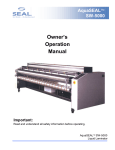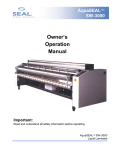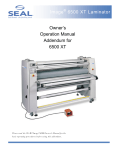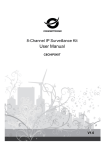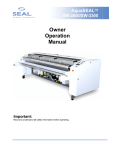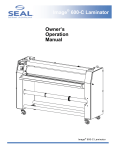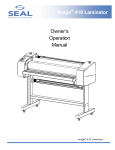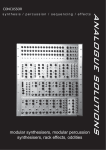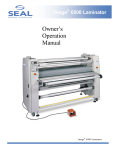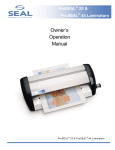Download SEAL AQUA AS-1600 Owner`s manual
Transcript
AquaSEAL AS-1600 Seal Brands … the finishing touch. Owner’s Operation Manual Important: Read and understand all safety information before operating. AquaSEAL AS-1600 Liquid Laminator Preface This manual contains the following Sections: Section 1. Introduction – provides a basic overview of the AquaSEAL™ AS1600 liquid laminator, and contains illustrations of the basic hardware components. Section 2. Operating Procedures – describes procedures for setting up, starting, stopping, and controlling the machine. Section 3. Troubleshooting/Miscellaneous – describes problems that may be encountered and lists corrective actions to resolve them. Information on who to call for after sales support. 1 Table of Contents General Warranty Statement Safety Information Safety Labels ……………………………………………………….. 3 …………………………………………...……………. ……………………………………………………………… 4-5 5 Section 1. Introduction Hardware Overview ………………………………………………………. 6-10 Section 2. Operating Procedures Tools / Supplies Needed …………………………………………………… 11 Loading the Sealant ………………………………………………………… 11 Loading the Media…………………………………………………………... 11 Pre-heat the Laminator ………………………..…………………………… 12 Web the Laminator……………………………………………………...…… 13 Run the Laminator ………………………………………………………..…. 14-15 Cleaning the Laminator……………………………………………..………. 16 Section 3. Troubleshooting/Miscellaneous Troubleshooting ……………………………………………………..……… 17 After Sales Support……..……………………...…………………………… 19 2 Warranty SEAL® Graphics warrants to the original consumer purchaser that each new SEAL® Image® Laminator, which proves defective in materials or workmanship within the applicable warranty period, will be repaired or, at our option, replaced without charge. Effective November 1st, 2002 the applicable warranty period for New Equipment shall be one year (parts), six months (labor and rollers) from date of purchase. This warranty extends to and is enforceable by only the original consumer purchaser, and only for the period (during the applicable term), which the product remains in the possession of the original consumer purchaser. "Original consumer purchaser" means the person who first purchased the product covered by this warranty other than for purpose of resale. This warranty does not apply if it is found that at any time the equipment has not been used for its intended purpose. Effective November 1st, 2002 the applicable warranty period for Refurbished Equipment shall be ninety days (parts and labor, excluding rollers). Rollers are not covered under warranty. The applicable warranty period for Demo Equipment shall vary, not exceeding the maximum warranty period stated herein. All Demo Equipment comes with a specific warranty, which will be stated at the time of purchase. If warranty period is not detailed in writing, there is no remaining warranty. Please ask your dealer, distributor, or sales representative for details. NOTE: Used and Not Refurbished Equipment is sold on an “AS IS” basis with No Warranty. For more information regarding this warranty, please contact your distributor. WARNING! Any unauthorized changes or modifications to this unit without our prior written approval will void the user’s warranty and will transfer health and safety obligations to the user. WARNING! Changes or modifications to this unit not expressly approved by the party responsible for compliance could void the user's authority to operate the equipment NOTE: This equipment has been tested and found to comply with the limits for a class A digital device, pursuant to part 15 of the FCC rules. These limits are designed to provide reasonable protection against harmful interference when the equipment is operated in a commercial environment. This equipment generates uses and can radiate radio frequency energy and, if not installed and used in accordance with Owner’s Manual, may cause harmful interference to radio communications. Operation of this equipment in a residential area is likely to cause harmful interference in which case the user will be required to correct the interference at their own expense. ©Copyright SEAL® Graphics 2002 All rights are reserved. No part of the document may be photocopied, reproduced, or translated to another language without the prior written consent of SEAL Graphics. The information contained in this document is subject to change without notice and should not be construed as a commitment by SEAL Graphics. SEAL Graphics assumes no responsibility for any errors that may appear in this document. Nor does it make expressed or implied warranty of any kind with regard to this material, including, but not limited to, the implied warranties of merchantability and fitness for a particular purpose. SEAL Graphics shall not be liable for incidental or consequential damages in connection with, or arising out of the furnishing, performance, or use of this document and the program material, which it describes. Trademarks Credits SEAL® is a registered trademark of SEAL Graphics. Image® is a registered trademark of SEAL Graphics. AquaSEAL® is a registered trademark of SEAL Graphics. ProSEAL® is a registered trademark of SEAL Graphics. 3 Safety Information Intended Use The AquaSEAL™ AS-1600 liquid a l minator is intended for use with medium and large format graphic output. Graphics can vary in widths up to 1.6M (5 ft.) in width and can be up to 90M (295 ft.) in length (dependent on thickness of media used). The AquaSEAL™ AS-1600 liquid laminator is intended for use with AquaSEAL™ water based sealant only. Use of solvent-based or other manufacturers sealants may damage the machine and may void any warranty. Safety Instructions Caution When handling any chemical products, read the manufacturers’ container labels and the Material Safety Data Sheets (MSDS) for important health, safety, and environmental information. To obtain MSDS Sheets for AquaSEAL™ Products, Please call your local distributor. In case of emergency, please telephone: +44 (0)1268 530 331 Europe, or (800) 486-6502 USA When using any equipment, always follow the manufacturers’ instructions for safe operation. Warning Avoid contact with heat source during use. Wear heat resistant gloves and safety glasses. Failure to avoid contact with hot surfaces may cause burns. Always observe manufacturers recommendations when handling chemicals. 4 Safety Information General q Do not operate the machine until it is connected to the proper power source. Refer to Installation instructions located inside control cabinet. q It is strongly recommended that the machine is fed from an “Earth Leakage” protected electrical outlet – if in doubt, please contact Hunt Technical Services (contact details in “Miscellaneous” section at the rear of the manual) or consult a licensed electrician. q Familiarize yourself with the layout of the Control Panel, and with the operation of the sealant delivery system. q Do not wear loose clothing, and contain loose hair to avoid becoming entangled with moving parts of the machine. q Comply with all safety warning signs, labels, and instructions. q Operators should be trained on the proper use of the machine and all safety procedures. q Provide fresh water, clean towels and rubber gloves for use during cleanup. q It is advisable to wear eye protection when filling/emptying sealant tank. Always Provide an approved emergency eyewash station adjacent to the machine. Figure 1 shows the safety labels that appear on the AquaSEAL™ AS-1600. Emergency Stop Labels High Voltage Warning Label Rotating Parts Warning Labels Temperature Warning Labels Figure 1. Safety Labels 5 Section 1. Introduction The AquaSEAL™ AS-1600 is a medium to large format media liquid laminator used to coat graphics with a protective sealant. Operating roll to roll, the media is threaded under the applicator mechanism, under the drying assembly, and onto the take-up roller. During operation, the liquid laminator applies sealant onto the printed graphics and then cures and dries it before winding the media onto the take-up core. Hardware Overview Figure 1.1 shows the front view of the liquid laminator. Major components (safety items shown in red) include the following: Dam Stop Assembly Draw Down Assembly Sealant Tank Unwind Mandrel Dryer Panel Applicator Nozzle Drip Tray Figure 1.1 AquaSEAL™ AS-1600 Liquid Laminator Front Views 6 Section 1. Introduction Hardware Overview (continued) q Two Emergency Stop Buttons are fitted to the machine, located prominently on top of both end cabinets. When pressed, all power is removed from the working parts of the machine. The machine cannot be used again until the Emergency Stop Buttons are reset twisting the button ¼ turn clockwise. When the emergency stop buttons are reset, the laminator powers up and the power switch must be reset to begin operation. q The Draw Down Assembly is located directly over the Drip Tray and is used to smooth the coating onto the surface of the media. It is manually raised and lowered by pivoting the assembly into it’s up or down positions. q The Dam Stop Assemblies are used to stop the coating from flowing off the edges of the media during operation. They are positioned at the edges of the media and are composed of two separate parts. An inner dam bracket is positioned on top and at the edges of the media and outer bracket positions up underneath the media to ensure that the dam stops hold a seal during operation. q The Drip Tray is located directly under the Draw Down Assembly and is used to catch any drips of coating that may fall off the edge or end of the media during operation. The Drip Tray pulls out the front of the machine for periodic cleaning. The Sealant Recovery Trays sit inside the Drip Tray. q The Sealant Tank is used to hold the supply of coating (18 liters/5 gallons). It is positioned on an overhead stand located on the left cabinet of the machine. The machine has no pump and the coating flows from the tank to the applicator nozzle by gravity feed and is controlled with flow control valves. q The Applicator Nozzle is used to control the flow of coating delivered to the surface of the media. Coating flows from the Sealant Tank to the Applicator Nozzle and is flooded onto the surface of the media. q The Unwind Mandrel is used to load a roll of media onto the front of the machine for roll to roll operation. It is a cantilevered assembly located low on the front of the machine. On the left side of the Unwind Mandrel is located a Tension Braking mechanism for applying back tension to the web. It is adjusted by turning the knurled collar. Core alignment is accomplished by sliding the core onto the mandrel and positioning in the desired position. Once the drive starts the Auto-grip bands will engage the core and enable the Tension Brake. 7 Section 1. Introduction Hardware Overview (continued) q The Take-up Mandrel is the primary drive for the machine used to pull the material through the machine and wind it onto the take-up core. It is a cantilevered assembly located low at the rear of the machine. It pivots from the left side of the machine and allows for the cores to be loaded and unloaded. Core alignment is accomplished by sliding the core onto the mandrel and positioning the core so it is aligned with the unwind core. Once the drive starts the Auto-grip bands will engage the core and begin pulling the media through the machine. q The Dryer Panel is located on top of the machine running between the two end cabinets. This assembly is used to dry and cure the coating before it winds up on the Take-up roller. Lifting the handle located on top of the panel raises the dryer panel. The Dryer panel should be in the up position during web-up and heat-up procedures. Once the machine is ready for operation it is lowered into it’s down position. Note: The Dryer Panel has fans in the top of it that force air through perforations in the face of the Heater. These fans are used to push humidity out of the Dryer Panel compartment and assist in drying the media. q The Control Panel contains all the displays, controls, and indicators required to operate the laminator. Refer to Figure 1.2 and its accompanying descriptions. • Main Power is used to turn power On and Off to the machine. It is also used to reset the machine after an E-stop switch has been depressed. • Heater is used to turn power On and Off to the Heater Assembly. • Temperature Controller is used to adjust the set point of the dryer panel. The temperature is adjusted by holding the set button down and using the UP and DOWN arrow buttons to scroll to the desired temperature setting. When power to the machine is ON the controller will display the actual temperature, and when the SET button is depressed, it will display its desired running temperature. The display on the controller will be ON regardless of whether the Heater switch is On or Off. • Speed Control is used to adjust the speed setting of the Drive. 8 Section 1. Introduction Hardware Overview (continued) Main Power Heaters Engaged Temperature Controller Speed Controller Figure 1.2 Control Panel q The Main Power Circuit Breakers provide over-current protection. Main Power Circuit Breakers Power Cable Entrance Figure 1.3 Circuit Breaker / Power Cable Entrance q The Power Cable Entrance is the point where the cable connected to the power source enters the machine. It connects the machine to the following power sources: • 228-240VAC, 50/60 Hz, single phase, 30 Amps. Maximum Power Consumption: 6000 Watts It is strongly recommended that the machine is fed from an “Earth Leakage” protected electrical outlet – if in doubt, please contact Seal Graphics Technical Services (listed at rear of manual) or consult a licensed electrician. 9 Section 1. Introduction Hardware Overview (continued) Figure 1.3 shows the rear view of the liquid laminator. Major components (safety items shown in red) include the following: Take-up Mandrel Figure 1.4 Rear View 10 Section 2. Operating Procedures All operating functions are initiated at the control panel. The following section outlines general procedures and describes specific functions used to coat media. This section is divided into the following sub-headings: 1. 2. 3. 4. 5. Loading Materials Pre-heat the laminator Web the laminator Run the laminator Cleaning the laminator Tools/Supplies Required: • • • • • Absorbent towels: soft, lint free, disposable Lab coat or smock Rubber gloves Bucket of water 3M Scotchbrite pad 1. Loading Materials Loading the Sealant: 1. Disconnect quick-connector fitting in supply line and remove the lid from the Sealant Tank. Figure 2.1 Quick Disconnect 2. Pour AquaSEAL™ 110 or AquaSEAL™ 510 into the Sealant Tank. The sealant tank holds 18 Liters (5 US gallons) of sealant. (Be careful not to add too much sealant to the tank.) 3. Position Sealant Tank onto the tank pedestal and reattach the quick-connector fitting in the supply line. (Ensure that the Flow control valve is closed) 4. Using rolled media, position the roll on the Unwind Mandrel. The media must be oriented to feed into the machine with the image side up. 11 Section 2. Operating Procedures 2. Pre-heat the Laminator All Pre-heat control operations are controlled from the Control Panel as shown in Figure 2.2 1. Switch machine to START at the Main Power Switch • Laminator will power-up • Dryer Panel is in the UP position. • Heaters are OFF. Set Button Up Button Down Button Figure 2.2 Heater Control locations 2. On the Heater Controller, press and hold the SET button to check the set-point temperature. Adjust the set point by holding the SET button down and using the UP/DOWN arrows to scroll to the desired temperature setting. Note: Most vinyl’s run well with a SET POINT temperature of 315°C (600°F) dependent on speed. 3. Press the Heater Switch to ON to power the Dryer Panel and begin heating. 4. Once the machine reaches its SET POINT it is ready to be operated. 12 Section 2. Operating Procedures 3. Web the Laminator A Web diagram is provided in Figure 2.3 Below Figure 2.3 Web Diagram Method 1. Lift Unwind Assembly to the UP position. 2. Load a take-up core onto the Take-up Mandrel and align with the edge of the roll of media on the Unwind Mandrel. 3. Pull media up over the web Idler, under the Draw down Assembly and under the Dryer Assembly to the Take-up Core. 4. Tape material to the Take-up core. Note: It is important to get the material as straight as possible to ensure a minimal amount of “telescoping” on the Take-up Roller. 13 Section 2. Operating Procedures 4. Run the Laminator 1. Lower Draw Down Assembly and secure locking pins. 2. Align right and left Dam Stop brackets into position at the edges of the media. The inner brackets align with the outer edges of the media and lock down by turning the red knob on top of the bracket. The outer brackets position similarly next to the inner brackets with the bracket roller sealing against the bottom of the media. Tighten in place with the red knob on the side of the bracket. 3. Open the Flow Control valves on the applicator Nozzle and begin filling the reservoir between the Dam Stops. Figure 2.4 Applicator Nozzle 4. Once coating is spanning between the two dam stops, lower the Dryer Assembly to the Down position. 5. Turn the Speed Control knob to the desired speed setting. 14 Section 2. Operating Procedures 6. Adjust Brake tension so that the material is pulling through smoothly with no wrinkles. Figure 2.5 Unwind Mandrel Brake Adjust 7. When the media being coated comes to an end, the last piece will loose tension; you will need to manually provide back-tension as the media runs out. 8. Approximately 1.6M (5 ft) prior to the last piece of media going past the Draw Down Assembly the Flow control valve at the Applicator Nozzle should be closed. 9. Once the material is through the Dryer Panel, the Dryer switch should be turned OFF. 10. The finished material is easily unloaded by swinging the Take-up Mandrel out and slipping the finished roll off the mandrel. 15 Section 2. Operating Procedures 5. Cleaning the Laminator 1. It is important to clean the machine immediately after the end of the material is completely through the Dryer panel. 2. Switch the machine to Stop on the Main Power Switch. 3. Pull Drip tray out 6 inches and raise the draw down assembly for cleaning. Figure 2.6 Clean Up View 4. Using a WET cloth, wipe the 2 draw down bars to remove any excess sealant from them. Note: Sometimes the tail end of the material will drag a little coating onto the stainless steel table behind the Draw Down Assembly. It needs to be cleaned off quickly because the heat from the Dryer Panel will dry it rapidly. 5. Dry the Draw Down bars with a clean dry cloth. 6. Put cap back on Applicator Nozzle. 16 Section 3. Troubleshooting The following table lists problems that may occur when using the AS1600 Liquid Laminator. Recommended corrective actions are provided for all commonly encountered problems. Problem / Symptom Causes Very thin coating Sealant is diluted with water Heavy coating Weight of coating in application area causes material to sag and not get wiped off properly Dirty Draw Down Bar Overly thinned coating can dry quickly and streak Contaminated coating can clump up and streak Media has been overheated Streaked finish Media wrinkles Unwind to take-up alignment is poor Insufficient back-tension Telescoping media Coated Media is wet coming out of the dryer panel Non-wets (areas where the sealant has not adhered to the film or paper) Distortions in media Cracking effect in the coating Surface impressions occur at the take-up roll Sealant in tank develops a skin over its surface Roll-feed to take-up alignment is poor Insufficient drying Media surface is contaminated Sealant is contaminated Media or inks and sealant are incompatible Media is too hot and is beginning to melt Media is hot and back tension is too high With thick coatings a high heat setting can cause evaporation to occur too rapidly causing this effect Insufficient drying Sealant has been left without agitation for too long and has begun to dry out Corrective Action Remove old coating and refill with new Increase break tension on the Transition and Tension Idlers Clean the Draw Down Bar Remove old coating and refill with new Remove old coating and refill with new Cool down heaters or speed up drive Realign the media Increase brake tension on Transition and Tension Idlers Realign the media • • Reduce web speed Increase the heat panel temperature Ensure media is free form contaminates Remove old coating and refill with new Use a compatible media Cool down the heaters and/or speed up the drive Decrease back tension • Lower heat controller o setting to 600 F • Check web temperature with IR gun • Reduce web speed • Increase heater panel temperature Pull skin off the top of the sealant and add a small amount of water (1 cup) and mix into sealant thoroughly. 17 Section 3. Troubleshooting 18 Section 3. After Sales Support SEAL Brands Technical Service (For technical assistance & service) SEAL Brands Technical Service – Europe and Asia Pacific (For technical assistance & service) For UK: Tel: +44 1268 722 400 Fax: +44 1268 729 442 or +44 870 125 5798 For NL: Tel: +31 572 345 500 Fax: +31 572 345 501 Tel: 1-800-486-6502 Fax: 1-800-966-4554 SEAL Brands Customer Service (For information and placing orders) Tel: 1-800-257-7325 Fax: 1-800-966-4554 SEAL Brands Customer Service - Europe (For information and placing orders) Tel: +31 572 345 500 Fax: +31 572 345 501 Note: SEAL Graphics recommends that your main power be installed by a licensed electrician in accordance with electrical codes in your area. Specifications subject to change without notice. Seal Graphics Americas Corporation 7091 Troy Hill Drive Elkridge, MD 21075 Tel: 410-379-5400 Fax: 410-579-8960 Seal Graphics Canada 1601 Matheson Blvd. E Unit #4 Mississauga, Ontario Canada, L4W 1H9 Tel: 905-212-9232 Fax: 905-212-9313 Seal Graphics U.K. Ltd Unit 1, 1 Watkins Close Burnt Mills Industrial Estate Basildon, Essex SS13 1BJ United Kingdom Tel: +44 1268 722 400 Fax: +44 1268 729 442 Seal Graphics Europe BV Kanaaldijk O.Z.3 P.O. Box 29, 8100 AA Raalte The Netherlands Tel: +31 572 345 500 Fax: +31 572 345 501 Seal Graphics Pacific Limited Unit A, 13th Floor, Block 1 Leader Industrial Centre Tsuen Wan, New Territories, Hong Kong Tel: +852 2407 3738 Fax: -852 2408 0973 www.sealbrands.com © 2002 SEAL Graphics SEAL and Image are registered trademarks of SEAL Graphics Part #OM1600-E Rev. 8 (11/02) 19




















